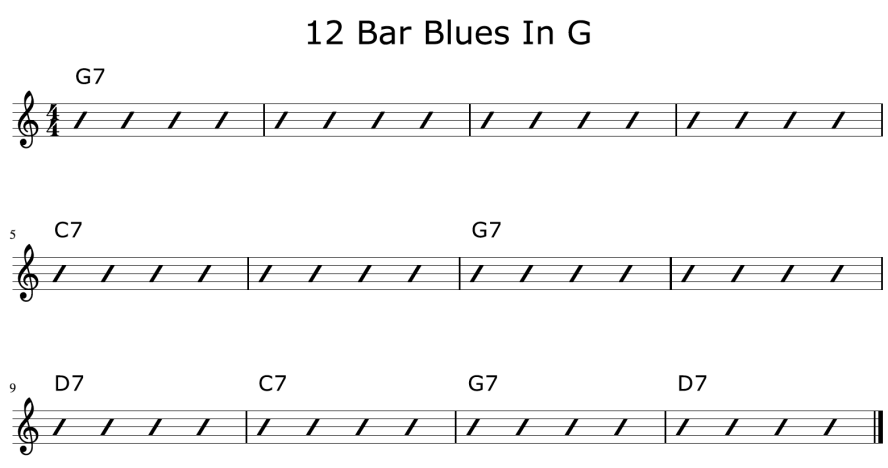In this free beginners blues harmonica lesson, we are going to learn 4 nice blues licks in 2nd position and then we will play them on the blues chord progression.
Indulge into lessons to discover nothing but sheer innovative and powerful methodologies integrated just for you to learn harmonica joyfully. You will notice how things turn out to be quite easy when you learn and play simultaneously - when you repeat after listening - and ultimately reaching the pinnacle of this sturdy process: enjoy harpin’
Blues has always been the king of styles when we talk about harmonica, and what further reassures it is that it only occurs after listening to the blues music, that the yearning to learn to play this musical instrument gets instilled into most of us and even grows stronger.
As this lesson aims for beginners, therefore, in order to yield the blues we'll use the notes which we can play without bending; using the pentatonic scale. The backing track lies in the key of G, moreover, we're going to use a C harmonica and play in second position.
As you will experience it yourself; i.e. learning with 'listen and repeat' approach is really valuable and joyous ; the use of the audio and visual metronome not only helps you keep up the tempo, but also enables you to equip yourself with just the right skills to perform later on the backing tracks or with a band.
Before practising, let’s have a look at the standard blues chord progression.
The standard 12 bars blues structure.
The 12-bar blues is a set of twelve musical measures forming the chord progression. Usually in the songs these measures set (chorus) is repeated several times, and just the characteristic of repetition of the chorus, makes the blues the genre on which everyone can improvise its own solos with any instrument.
The chords that form the harmonic progression of the 12 bars blues are the 1st, the 4th and the 5ft, also named I, IV and V. Most of the blues use seventh chords, I7, IV7 and V7, where the seventh degree of the chord is minor. For example, a G blues would have G7, C7 and V7 chords.
The chords are named as grade 1, 4 and 5, because the harmonization of the G scale sees the note G as 1st degree, the note C as 4th degree and the note D as fifth degree.

The twelve chorus measures are divided as follows:
4 measures on the 1st chord.
2 measures on the 4th chord.
2 measures on the 1st chord.
1 measure on the 5th chord.
1 measure on the 4th chord.
1 measure on the 1st chord.
1 measure on the 5th chord.

The G blues will have the following chords:
G7, G7, G7, G7,
C7, C7, G7, G7
D7, C7, G7, D7.

the 12 bars blues is not the unique structure of blues that we know, there are several structures with variations, this one that I have introduced is however one of the simplest.
In order to follow this lesson, have a look at the notation rules below:
How to read the TABS:
Hole number and + means blow.
Hole number alone means draw.
123 means draw holes 1,2 and 3 as a chord.
123+ means blow holes 1,2 and 3 as a chord.
123x2 means play twice the chord 123 in the same measure beat.
' means half-step bend.
'' means two-steps bend.
''' means three-steps bend.
> means hold the last note.
. means pull or slap articulation.
| is the beat eights separator.
1|2 means play 1 and then 2, the duration of each is 1/8.
1|2|3 means play 1 then 2, then 3 as a triplet.
a Semicircle is a legato between two notes.
Sh means shake.
Flutter means tongue flutter.
Now it’s time to play! Just follow your teacher in the interactive videos. First, we will practise the single licks, then we'll play them all on the backing track. Here is the first lick: enjoy!
Now have a listen to the whole chorus:
In the following video you can practise alone on the backing track:
As you have experienced yourself, learning using the ‘listen and repeat’ approach is really valuable and funny. The use of the audio and visual metronome helps you to keep the tempo and makes you to acquire the right skills to perform later on the backing tracks or with a band.
I’m pretty sure you enjoied learning with me and I hope to see you soon in a more complete harmonicalearning.com course, like the ‘ Diatonic harmonica beginner course’. Keep harpin’ !
Want to learn more about our courses? Click on the following image to get to our online harmonica school.
If you want to comment this lesson use the contact form available here.
Marcus Lee
I can't bend on all holes yet, i mean, I can bend on holes 2 and 3, but somehow, I can't still bend on hole 4, would you suggest me a way to fix this?
Def Stephard
When I jam, I Just play it by ear and put my heart about it. I produce great results, but I think that some of your lessons like this one can really add something to my skills. Thank you, Sir for this blues riffs!
Edward Deloyd
What an excellent lesson. I'm just a beginner harmonica player and I'll replay it again and again while I play along until I get some of those phrases into my repertoire. Thanks a lot!